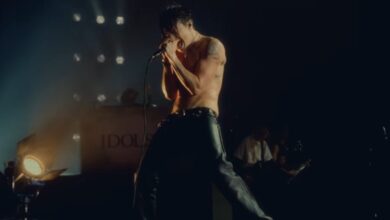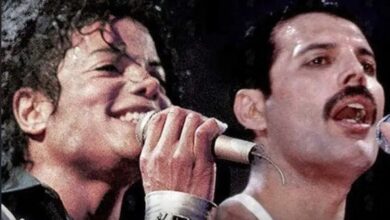Erik Grönwall Delivers the Most Powerful Rendition of “House of the Rising Sun,” Leaving Longtime Animals Fans in Absolute Awe
Former Skid Row powerhouse Erik Grönwall stepped away from the band last year to focus on healing after his leukemia diagnosis, but his comeback has proven that neither his voice nor his fire has faded in the slightest. In fact, he stunned rock fans worldwide by releasing what many are now calling the most intense and emotionally charged version of The Animals’ 1964 classic “House of the Rising Sun.” Even listeners loyal to the original were left in silence, surprised that someone could modernize it without losing its soul.
When Erik labeled the performance “House of the Rising Sun (Epic Dark Version),” he meant every word. The song opens with a chilling, gothic-style piano that sounds like it belongs in a shadowy cathedral, and out of that fog his voice appears—smoky, controlled, and haunting. Instead of rushing straight into big high notes like most singers do with this track, he holds back, telling the story slowly, like someone who has lived it, letting tension rise line by line until the listener is fully trapped inside the atmosphere he’s built.
As the first verses unfold, Erik begins layering ghostly harmonies over himself, creating an eerie choir effect that sounds both soothing and sinister at the same time. A subtle prog-style organ hides in the background, adding to the old-world tension before the arrangement finally erupts. About halfway in, the percussion hits and Erik’s voice turns from storyteller to conqueror, pushing out perfectly timed power notes that explode right when the production needs them, showing just how well he understands dynamics.
Right when fans think this is going to stay a mellow, dark reinterpretation, Erik flips the entire concept on its head. Out of nowhere, the song is swallowed by thick, cinematic guitars, and his metal background storms into the track with total authority. What once sounded like a smoky club ballad suddenly transforms into a full symphonic metal anthem, and the 1960s blues tragedy becomes a modern, theatrical epic. It’s the kind of makeover that makes you hear a song you’ve known for 60 years like it’s brand new.
Even if you don’t usually listen to metal, this cover is worth hearing because Erik doesn’t use heavy guitars just to make noise—he uses them like colors, adding depth, weight, and drama to a song everyone thought had already reached its final form. Every riff feels sculpted, every drum hit supports his voice, and when he shifts into the key change, the entire mix takes on a cathedral-like darkness. Choir-style backing vocals echo behind him, giving his biggest high note the impact of a movie finale, before he gently slides down into a bluesy, wounded melody.
Then, just when it sounds like he’s finished reinventing the song, he pulls off one last surprise. The arrangement strips back to a delicate, slightly creepy piano line that could have come straight from a Tim Burton film score, and over it Erik sings in a fragile falsetto—soft, damaged, confessional. It’s the kind of ending that makes the whole song feel like a sinner’s testimony, as if the character in the lyrics is finally admitting everything. That contrast between violent power and whispered regret is what makes this version feel cinematic.
Within only two months of being posted on YouTube, the video racked up around 1.8 million views, which is pretty wild for a cover of a song that’s been covered thousands of times already. That kind of response shows that Erik didn’t just do a good version—he unlocked something inside the song that people still wanted to feel. He tapped into fans who have been singing “House of the Rising Sun” since the 1960s and somehow convinced them that it could still surprise them in 2020s-era production.
The comment section is basically a museum of shocked reactions from older listeners. People in their 60s and 70s jumped in to say things like, “I’m 70 years old and this is the best version I’ve heard,” and, “I’ve heard countless takes on this song, and this is the first one that gave me chills again.” One viewer wrote a perfect comparison that Erik liked himself: “The original is like an old sepia photo… this one is full 3D Ultra-HD.” It’s rare for a young singer to win over fans of the original like that.
What makes the whole thing even more emotional is that many viewers knew about Erik’s cancer journey, and seeing him not just healthy but singing with even more power than before hit people hard. Several cancer survivors or people close to patients commented about how inspiring it was to watch someone come back from leukemia and deliver vocals like that. One person summed up the whole energy of the performance with a single line: “He sang it with so much passion that I can believe he has lived every word.”
This version doesn’t just show vocal skills—it proves that Erik Grönwall is one of those rare singers who can pull emotion out of a song that everyone thinks they already understand. His take is darker, more theatrical, and more story-driven than most rock covers, yet it still respects the original blues skeleton. That balance—between paying tribute and reinventing—is what makes this performance feel less like a cover and more like a reincarnation of the song for a new generation.
It also spotlights something people sometimes forget about songs from the 1960s: many of them were written to be retold, reshaped, and re-suffered by different voices. Erik treats “House of the Rising Sun” like a piece of folklore, not a museum item. By adding metal, gothic textures, eerie pianos, and choral backings, he reveals how flexible the melody actually is. Instead of softening it, he leans into the tragedy of the lyrics and stretches them into something almost cinematic-horror in tone.
Visually and sonically, the whole production feels like it was built to match his current chapter in life—survival, darkness, and defiance. There’s a certain pain in his tone that doesn’t sound fake or theatrical; it sounds earned. That’s probably why older fans and rock purists accepted it so easily. They weren’t just hearing a singer showing off; they were hearing a man who went through real struggle and turned it into art. That authenticity is what makes this version stick with you after it ends.
At the same time, his performance quietly challenges the idea that classic rock songs have to stay in the era they were born in. Erik proves they can be dragged into the present, dressed in modern production, and still keep their emotional punch. In doing so, he opened the door for more metal-meets-vintage reinterpretations—because if “House of the Rising Sun” can become a gothic metal epic and still feel right, then almost any classic can be reborn this way.
In the end, Erik Grönwall didn’t just cover a legendary track—he reminded everyone why it became legendary in the first place. He uncovered the desperation, the warning, the sin, the regret, and the spiritual ache inside the lyrics, then amplified all of it with modern heaviness. Coming from someone who fought back from illness, the performance lands even harder. It’s the sound of a singer refusing to fade, taking an old song about ruin and turning it into a personal statement about survival.





